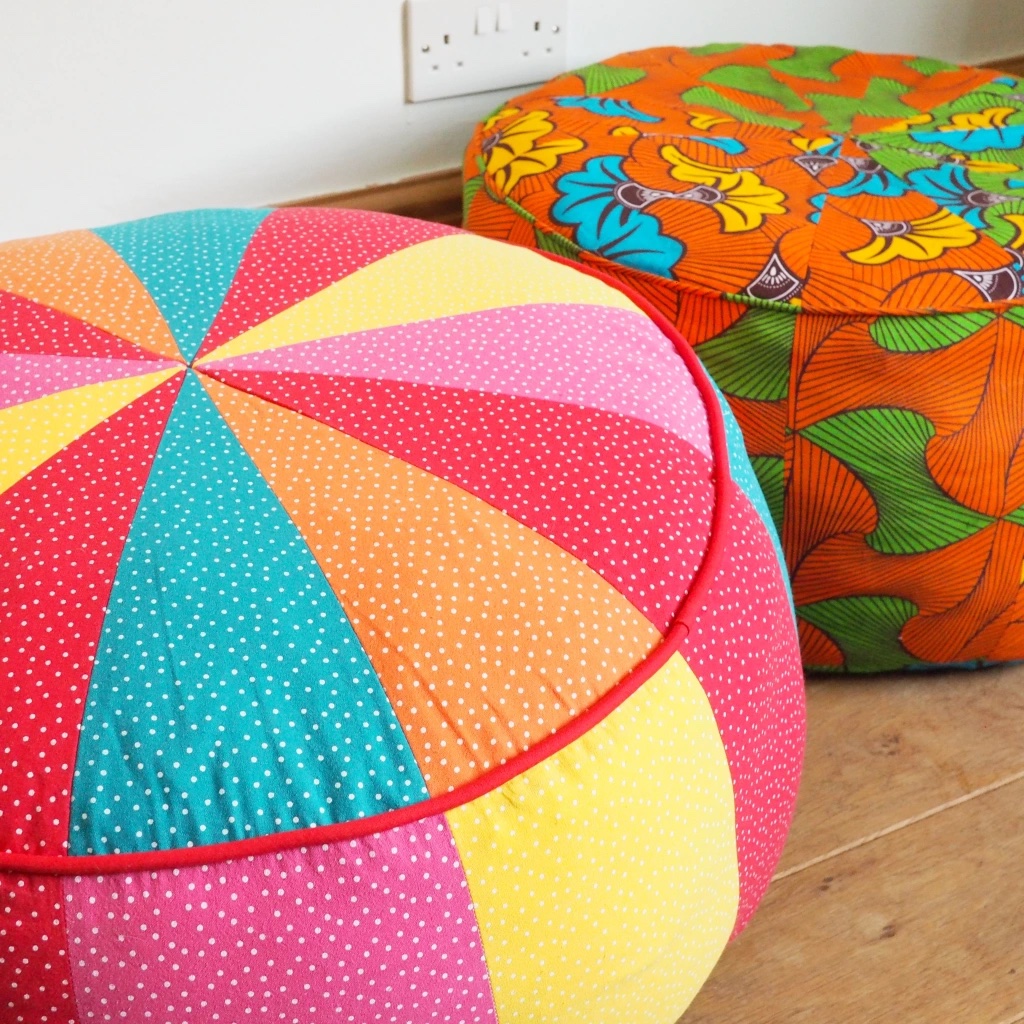I’ve now made two of these floor poufs by Closet Core Patterns – and I love them both!

This pattern has been written about a lot in the sewing community, and is very well-loved. I completely understand why: not only do you end up with a fun and practical pouf (useful as a seat, a footrest, or a majestic throne for a cat) but it also scores very nicely in the sustainability department. It can be made from fabric scraps, and it can be stuffed full of whatever bits of fabric you have lying around – scraps, cutoffs, bits of thread or yarn, retired blankets, ancient towels, the ugly curtains that were hanging in your house when you moved in, ratty old faded knickers (clean ones!), etc. Each pouf holds an inconceivable amount of otherwise purposeless fabric.
I’ve always had a guilty conscience about my fabric waste. I’ve struggled to find a reliable way to recycle fabric waste in the UK – I used to donate it to H&M, but I’ve read things that make me very sceptical about what they do with it. One of the reasons I sew my own clothing is to reduce consumption, so I felt uncomfortable about replacing that consumption with waste. But these poufs mean that I make use of literally every scrap of fabric I buy. Even the really tiny useless ones. Shove ’em in a pouf. Boom.
And it’s a free pattern! Blows my mind.
If you’d like to sew your own Closet Core Pouf, the original tutorial is superb and easy to follow. But here are some of my extra tips!

1. Don’t finish the curved edges of the segment pieces during the initial overlocking phase.
It’s easier to do them all in one go once you’ve sewn the whole circle together – or even once you’ve attached the piping.
2. Don’t sweat the matching in the centre.
You might not get those little points to perfectly sit together. It’s fine. In the original sewalong by Closet Core Patterns themselves, that centre section doesn’t match up perfectly either. So what, who cares – just do your best! You can always sew a cute button on the top to conceal the joins – or even turn it into a design feature with some applique, like @pimp_slapped’s version.

3. Use an adjustable zipper foot for the piping.
For my rainbow pouf, I used store-bought piping that had a diameter of about 10mm. Turns out 10mm is ginormous. The standard zipper foot that came with my machine just could not handle it – I couldn’t get my needle close enough to the piping.
After a lot of frustration, I figured out that what I needed was an adjustable zipper foot (not an affiliate link!). This kind of foot lets you move the presser foot portion from side to side, so you can position your needle right at the edge of the foot. It’s magic.
You can, of course, use a piping foot. But I couldn’t find one that would accommodate such large piping. If you’re going to splash out on one or the other type of foot, I’d recommend the adjustable zipper foot – because it is less specialised and can be used in other situations where you need to sew super close to the edge of the foot. (When sewing zippers, for example!)
4. Your piping doesn’t have to have a 3/8″ flange.
Apparently the tape part of piping is called the flange. Heh.
I used readymade piping for my rainbow pouf and it had a 5/8″ flange. I trimmed it down for the top and completely forgot to do that for the bottom. The world didn’t burn down. It was fine.
In fact it was a bit easier to manhandle it with the bigger seam allowance.

5. Take extra care to hold the sides out of the way when attaching the piping.
This probably goes without saying, but I want to emphasise it because I screwed it up so many times: it’s super easy to accidentally catch the sides and sew enormous tucks while attaching the piping, especially if you’re attaching it pin-free (which I also recommend, by the way). Hold that fabric well out of the way, and keep checking that it hasn’t moved under your sewing needle as you go.
6. The inner bag is definitely optional.
You can still wash your pouf even if you don’t make an inner bag – you just need to find somewhere to stash all those scraps in the meantime!
I made an inner bag (basic drawstring style) the first time round, and I found it made it hard to stuff the pouf into a good shape without the inner bag resisting me. I ended up taking it out, and now I use that bag to store scraps for my next pouf.
Because yes, there will be more poufs.

